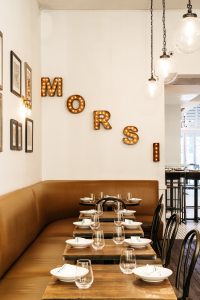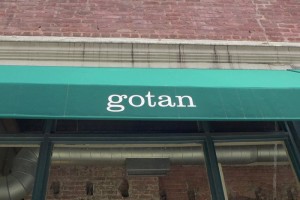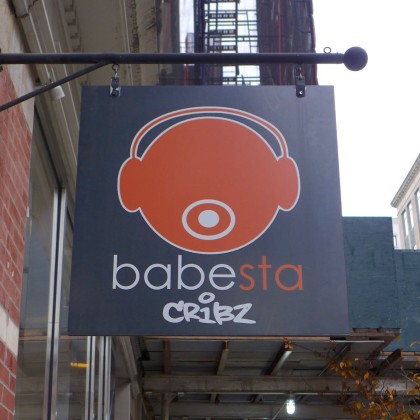The Tribeca Pronunciation Guide
I’ve updated the guide here because so many businesses have opened and closed. The back story of this guide is in the original post.
I stopped by or called every business with a name whose pronunciation could cause confusion — and there are a lot. Some will be obvious to you, but having been surprised several times, I decided to cast a wide net. I’m no expert on phonetics, so I did my best to make them as clear as possible. Put the stress where the italics are.
First, here are the Italian-(and Latin-)derived names.
• Marc Forgione for-jee-own (now conveniently called Forge)
• Da Mikele dah mee-kay-leh
• Scalini Fedeli skah-lee-nee feh-dell-ee
• Tre Sorelle tray sohr-ell (In Italian, it’s pronounced tray sohr-ell-eh, but they Franco-Americanized it)
• Sole di Capri soh-lay dee kah-pree
• Tutto Il Giorno too-toh eel jyor-noh
And on to the French/Franglais:
• Desbrosses Street I defer to historian Oliver E. Allen, author of Tribeca: A Pictorial History: “The Des is most likely Dess, and I’d say the brosses rhymes with bosses. It’s hard to say, though: It’s an Anglicization of a French name, and we don’t know how people pronounced it when they first converted it to English.” I didn’t ask, but I assume the accent is on “brosses.”
• Albert Capsouto Park al-behr cap-soo-toh
• Bouley Botanical boo-lay
• Terroir teh-rwahr (they said “teh-rwah” was too pretentious)
• Le Pain Quotidien leh pahn koh-ti-dee-yahn (the “n” at the end is more of an implication than an actual sound)
• Racines NY rah-seen crossed out because it is now Chambers
• La Garçonne lah gar-sohn
• Bâtard bah-tard
• Vin des Amis vehn dayz ah-mee
• Jacadi zhawk-ah-dee
• Belle Reve bell rev
Other foreign-derived names:
• Falafel Tanami ta-na-mee
• Blaue Gans blau-eh gahnz
• Kaffe Åre Kaffe is “coffee” in Swedish, but they say “café” like it’s French and then Oar-ra
• Otte awt
• The Odeon oh-dee-ahn
• Jungsik yung shik
• Issey Miyake eee-say mee-yah-kay
• Zutto zoo-toh (the “zoo” is very quick)
• Azabu ah-zah-boo
• Nili Lotan nee-lee loh-tahn
• Polarn O. Pyret poh-larn-oh-peer-eht
• Aire Ancient Baths eye-ray
• Benares ben-ahr-ehs
• Shigure shih-guh-ray
• Fika fee-kuh
• A Uno Tribeca ay (rhymes with hey) ooh-noh
• Stillfried Wien still-freed veen
• Gunbae gun-bay
• Añejo ah-nyay-ho
• Abhaya ah-bye-uh
• Livly liv-lee (the first syllable is “live” as in “and let die”)
• Sapar Contemporary sah-pahr
• Aahar Indian Cuisine ah-hahr
• ONDA Beauty ahn-duh
 And then there are names that aren’t foreign-derived (or might be but I have yet to look them up):
And then there are names that aren’t foreign-derived (or might be but I have yet to look them up):
• Laight Street “Laight is definitely Late.” —Oliver E. Allen
• Smyth smith
• Babesta bayb-stuh (like gangsta, but for babes)
• Vesey Street vee-see (says Oliver E. Allen)
• Fiterman Hall fit-er-mehn
• Shinola shy-noh-luh
• Gotan goh-tahn
• James Perse purse
• Bar Cyrk sirk
• Arrojo ah-roh-joh
• Alumnae ah-luhm-knee
• Foundrae found-ray
A surprising number of businesses admitted that customers and suppliers often get their names wrong. Then again, many business said they didn’t care what you call them, just as long as you call them. If I missed any, let me know in comments.














From the book “Every-day English – A Sequel to ‘Words and Their Uses.’ ” by Richard Grant White (1880)
In the city of New York there has been of very late years a remarkable change of name effected by this rule of spelling-book. “What,” said to me elderly gentleman, a member of a highly respected old New York family, ” what do these people mean by Dez bros-sez Street? There’s no such street. The name is De Broose Street.” He then informed me that the street was named after a family whose name was spelled “Desbrosses,” but pronounced De Broose, and that until it appeared on the street cars it was always so pronounced.
From The Knickerbocker Volume 47 (1856):
The most eminent civilians with whom I became acquainted after our removal to this city, were John Jay, Rufus King, Gouverneur Morris, Egbert Benson, and Chancellor Livingston; […] and the most prominent among the merchants and bankers were James Desbrosses, (pronounced De Bruce,) […]
From “The American Language – An Inquiry Into the Development of English in the United States” By Henry Louis Mencken · 1923
A large number New York street and neighborhood names come down from Knickerbocker days, often greatly changed in pronunciation. Desbrosses offers an example. The Dutch called it de Broose, but in New York today it is commonly spoken of as Des-bros-sez
From https://en.wikipedia.org/wiki/Debruce,_New_York
De Bruce is a small hamlet located in Sullivan County, New York, United States. […]
The name, De Bruce, is derived from one of its early European investors, Elias DesBrosses, a French Huguenot who with Renssalier (sic) and others, escaped from France and persecution, living in the Netherlands. With others he invested in the New World. While he remained in Europe, his offspring became wealthy land owners and were involved in New York politics.
From The New York Times
“F.Y.I.” By Michael Pollak
June 27, 2004
Section 14, Page 2 of the National edition
Roots in Rum
Q. I live on a small block in TriBeCa called Desbrosses Street. Who is it named for and what did they do to merit a street named after them?
A. According to ”The Street Book” by Henry Moscow and ”Naming New York” by Sanna Feirstein, Desbrosses Street was named for Elias DesBrosses (1718-1778), a Colonial alderman, warden of Trinity Church and third president of the New York Chamber of Commerce.
The son of a 17th-century Huguenot immigrant, DesBrosses started his career as a confectioner, but went into the import-export business, trading chiefly with the West Indies and Madeira. His fortune was built partly on rum. He was one of the city’s biggest real estate owners when he died. His French Huguenot ancestry suggests that the name should be pronounced day-BRUSS.
Jungshik -> Juhng Sihk 정식
I just LOVE this thread! More of this please. One add to the list: Macao Trading Company. “Mah- Cow” has one of the strongest cocktails list in Tribeca. My only criticism is they rarely update any of their menus.
And to Chefs Phet and Forgione (“Fore- joan- ay” in Italia!) we miss Khe-Yo! It was the great bookend to Macao…